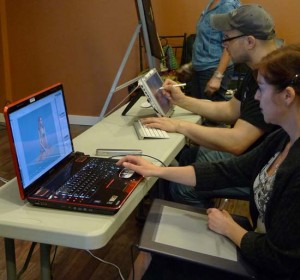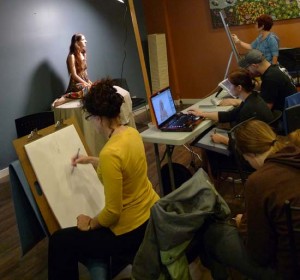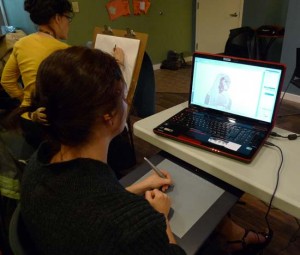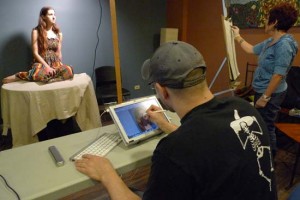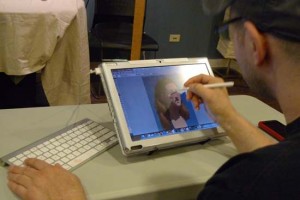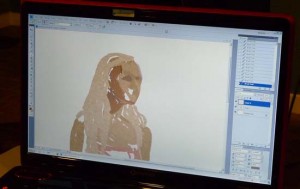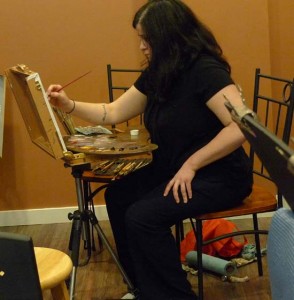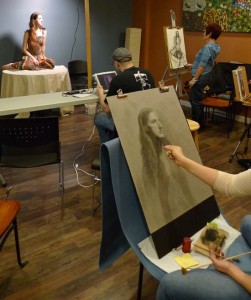Art & Culture
Digital Art Demonstration
In this digital age, we praise the tools new gadgets provide us with and the efficiency they generate, but we also lament the projected demise of non-digital methods and the tactile experience they hold for us. Some even presume that our reliance on modern technology makes us ‘lazy’ and keeps us from learning the skills necessary to function without a phone in our pocket.
Debunking that lack of skill in the arts world was a drawing session with the Chicago Painters and Artists Group this weekend. Organizer Jennifer Yang arranged for two digital artists to demonstrate their creative process with a live model.
Marina and Grigor demonstrate digital drawing
Photoshop is a computer graphics program developed in 1987 and launched in 1990 that can be perceived as both helpful and a hindrance to creation. The colloquialism of “being photoshopped†implies that an image is no longer true to reality, usually with the intention to deceive. This prevalence requires digital artists to clarify their process. After the last Meetup, an artist stated that he uses photos as reference to draw his art work from by hand, but people often assume he uses the photographs directly and manipulates them in his computer.
Digital artistry can be just as ‘old school’ as charcoal and paper, without the use of plug-ins and computer-aided manipulation. Brittany Nopar posed for a three-hour session as a group of 10 artists drew her from life. A paintress mixed colors and created an umber wash before applying oil paints to the study. Others sketched out the model in charcoal. Meanwhile, Marina and Grigor started a base sketch on their electronic devices.
Marina uses a Wacom Intuos 2 tablet that connects to her laptop computer. She likes it better than the touchscreen tablet Grigor uses, because her arm tires when holding the pencil tool up against a screen. With the tablet on her lap, she feels more comfortable and efficient.
Grigor purchased a Mac-based tablet a while back, and recommends the ASUS EP121 for digital artists. Both artists use Photoshop to sketch and draw (the program is both PC and Mac-compatible). I have heard of artists using Paint as well.
Like the varying styles of the artists in the room, Grigor and Marina worked differently. Grigor used his tablet very much like a traditional canvas. He mixed colors on the side of the sketch and created what looked like a painting to me. He doesn’t print out his art, but uses it as a digital archive to draw from when creating paintings or charcoal drawings on traditional media.
Marina uses her digital art for business, and has created printed books and posters. To me, her strokes looked more like pencil sketching. Her drawing became more whimsical in the end, in line with the type of art she usually creates. Self-taught on the computer, Marina enjoys the layer function in Photoshop, but utilizes her technical art training to develop her image from sketch to shading/color depth, to a finished version. She will group an image such as a christmas tree together to ‘collage’ it into a card or poster with a snowman, a process done with a few key strokes and cursor moves.
Both agree that digital art can be more efficient than the ‘old world’ tools. It is faster and cleaner. Grigor also finds the tablet beneficial in spaces where there is limited light.
However, the skill of drawing with a tablet does require technical training (or talent). As Grigor put it “it is just a tool.†He said that without knowing how to draw or paint, drawing on a tablet will not generate the professional image he created. The traditional “pencil and paper†skills still apply with a digital tablet.
Although the digital process is faster than using traditional artist’s tools, Grigor still spent the full 3 hours working on his piece. Meanwhile, the charcoal artists and oil paintress left with pieces in various stages of completion, but all looked lovely to my eyes.

